The Way It Is/ NASCAR's new look for 2013by Gordon Kirby |
 NASCAR's last big change came in 2007 with the birth of the 'Car of Tomorrow'. The new car was safer and equalized the field a little more, but its spec car nature robbed the cars of any brand identity and the CoT was received tepidly by the fans. A weak economy added to the problem so that crowds have fallen off in general in recent years and plunged precipitously at some tracks.
NASCAR's last big change came in 2007 with the birth of the 'Car of Tomorrow'. The new car was safer and equalized the field a little more, but its spec car nature robbed the cars of any brand identity and the CoT was received tepidly by the fans. A weak economy added to the problem so that crowds have fallen off in general in recent years and plunged precipitously at some tracks.
Thus comes NASCAR's 2013 Sprint Cup car with much more brand identity. All four competing manufacturers--Chevrolet, Ford, Toyota and Dodge--have worked closely with NASCAR over the past year to formulate the look and template package for the new car. Serious testing of the 2013 car gets underway this month and the teams will be flat-out over NASCAR's brief off-season building fleets of new cars to debut at next February's Daytona 500. "It's upon us," commented Robin Pemberton, NASCAR's vice-president of competition. "Our objectives and our goals have been met as far as what we like to call our product relevance--the look of the car and how much it resembles the street versions of the various manufacturers. We're really pleased with that. We've been working on our package for aero and mechanical grip. We've done a lot of testing, a lot of simulation work and scale model work, and lots of wind tunnel work." 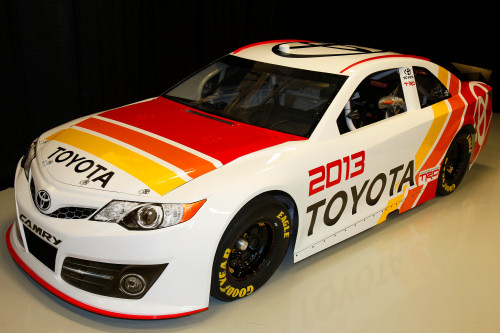 © Toyota Racing "The whole process has been unlike anything I've ever seen in the sport," Graves declared. "Generally, when there are big initiatives from NASCAR they ask for information. They ask for bits and pieces from the manufacturers and the teams. From the start this process was heading in that same direction but the manufacturers got together and we approached NASCAR. We asked if we could have more say and we outlined our goals for the project. "We felt like the only way for this project to be truly successful was for the manufacturers to all try to work together and pledge that we were trying to make some suggestions that were based on what's best for the sport and not our individual needs. We wanted to lay a foundation and a box of parameters to design the cars to. Then we could go off and do our own designs and work on our own stuff. "Robin, John Darby and Mike Helton and everyone inside NASCAR was very receptive to that. I feel like if it wasn't for the people who were involved and Robin knowing all of us so well, I think he felt comfortable that we could come up with a set of parameters. We worked hard and worked with NASCAR. "All four of the manufacturers have had to give in areas of give and take for what's best for the series and lay a foundation for the future. We're proud to be a part of the process because I truly believe it's going to define a new era in NASCAR." Pat di Marco is Ford's NASCAR program manager. Di Marco has been with Ford for twenty years and has worked as an engineer for top Ford teams in NASCAR and CART. These days he oversees all elements of Ford's engineering partnership with its NASCAR teams. "It was a foreign concept to all of us to sit in a room and collectively work towards a common goal," di Marco observed about the process of designing the 2013 car. "The first time we got together in a big group with NASCAR everybody was on the same page. We all wanted to move towards more brand identity. But at the beginning we all kept everything close to our chests and you questioned everything that came out of somebody's mouth. You asked, what are they trying to hide? What are they trying to get by you? That's the human nature of racing. "It wasn't all hunky-dorey. We weren't all on the same page on everything that we were trying to accomplish. But for the greater good of the sport we all made compromises and decisions that would help the overall good of the sport. 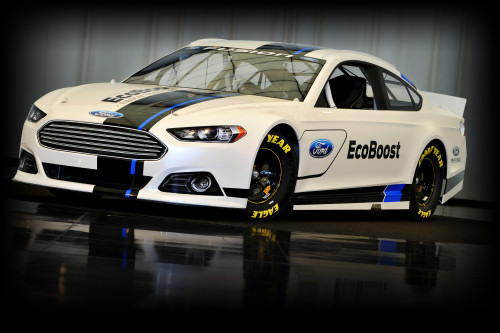 © Ford Racing Andy Graves pointed out that there were some good points about the 'Car of Tomorrow' that needed to be retained in the new car. "The reality is that the CoT is a bit of an IROC car," Graves said. "I know NASCAR hates that term but really, other than the nose and the hood, it's pretty much the same for all competitors and the fans haven't really embraced it. But the one good thing that's come out of it from the manufacturers' point of view that we've never seen is I don't get calls on Monday morning from the Gibbs or Waltrip folks saying Toyota doesn't have the same aero performance as the Chevrolets or the Fords or Dodges. "Those conversations used to happen on a weekly basis and they're gone. Now I get phone calls on Monday mornings asking how can we pick up our game to match our counterpart. But we're never at a disadvantage to another manufacturer. That's one thing that we all identified. It's good for the sport to have a mix and have all the manufacturers have a shot to be competitive. "So the goals for the 2013 car were to somehow keep that balance. But we needed a lot more identity in the cars to make them look like each brand and we need to get the fan base back where they're cheering for their favorite car. It's great that they cheer for their favorite drivers but we want the true-blue Chevrolet fan to cheer for all the Chevrolets and for the Ford and Toyota fans to do the same for their favorite brand." Graves believes the communal work between the manufacturers and NASCAR will achieve their individual and collective goals. "It took us over a year to get the parameters before we even started design work on our cars," Graves related. "We wanted to lock in the areas that we knew you could make big adjustments for big performance gains, but also leave open the areas where it really doesn't matter. We wanted to make it so you could also put a lot of style and character into the cars. "I think you see that when you look at the 2013 cars. They perfectly fit those parameters. They are all scary close in the wind tunnel and yet they look totally different to the average fan. It wasn't an easy task. It took a lot of computer and simulation work to get to that point but we feel that we have a foundation that's really a win-win situation for everybody involved." 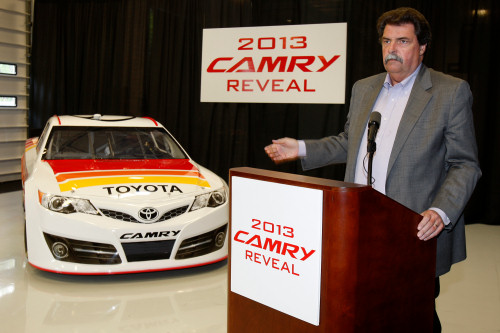 © Toyota Racing "The CoT did one thing for the sport and that was the safety aspect of it," di Marco said. "Two things going into this that I think all the manufacturers agreed on from the starting point was that we need to keep it safe. Therefore, we kept the chassis and underbody of the car the same. "And on the heels of a championship that Tony won by a tie-breaker, we wanted to keep the high level of competition that's carried forward this year where Kyle Busch missed the Chase by three or four points. The competition level today is very good and we didn't want to mess that up. We wanted to make sure that we stayed in the box where the competition level remains as high and the safety wasn't compromised in any way. "So we tried as manufacturers to make sure that the cars had the same handling characteristics and the same performance both in traffic and running by themselves. We wanted to retain that competition level in 2013 and I think from the few tests we've had with the new car so far at Homestead and Martinsville, collectively the drivers have said they drive like my current car. I think that's a statement that says the OEM groups and NASCAR have accomplished what we were after and the effort that went into it." Robin Pemberton commented on NASCAR's view of the CoT's improved safety. Pemberton also pointed out that some detail modifications to the rollcage have been mandated for next year. "The safety cell we've developed with the current car is there and will always remain," Pemberton said. "The teams still have the ability, as they've always had, to run their own proprietary geometries and things like that. That's always been the case and that will continue. "We have an update to the chassis for safety. We've done some roof drop and rollover tests and a bulletin went out for that last month. A couple of bars are being added to the roof structure. They'll continue to build new cars and retro-fit this year's cars with that roof structure." Andy Graves added an observation about safety. "When we stepped forward and asked to have more input than normal into the process," Graves said, "the biggest stipulation from the get-go from Robin and John Darby's points of view was to keep within the envelope that we have with the current chassis. They didn't want to have everybody have to change all the chassis and all the bodies all at once. "NASCAR is always working on safety initiatives and they came up with some roll cage updates that can be easily implemented in the current chassis and don't encroach on the body envelope and styling. And that again is a positive for everybody involved." Pemberton said that despite the changes in styling and appearance he doesn't foresee any difference in the way the new car drafts or works aerodynamically. "I think everyone has a good understanding of the aero," Pemberton observed. "With the amount of wind tunnel time and the understanding the teams have with proper rolling road wind tunnels that are out there these days it allows our guys to work on their cars with proper aero mapping and so forth. There won't be any surprises." 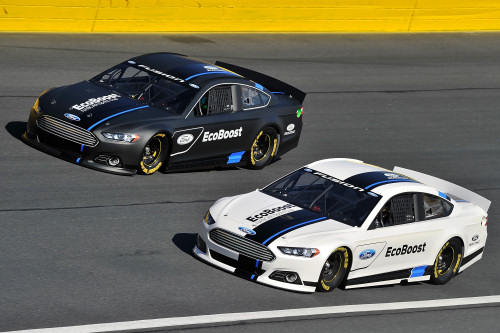 © Ford Racing "I think it's going to be probably similar to what we've seen this year," Graves said. "Daytona and Talladega have always been a huge challenge as long as I've been in the sport and it'll probably always continue to be a challenge. Anytime you have wide-open racing the cars form into packs and get into close proximity. I don't really expect anything earth-shakingly different." Pat di Marco shares Pemberton and Graves' confidence in how the 2013 car will draft and race. "The restrictor plate racing will have the pack racing that we've had at Daytona and Talladega," di Marco said. "NASCAR is working with us to make sure we get the cooling correct and we have pack drafting and not the tandem racing, which the fans have told us they don't like. "Trying to do that with a car that's not common anymore is proving to be a challenge but with all three OEMs working with NASCAR collectively we have more resources to put toward it and more engineering behind it. So I think we'll solve the problem and make sure that we keep the competition and the racing at the level it is today." NASCAR has also decided to try to reduce the dependence on aerodynamic downforce by trimming the size of spoilers and splitters for next year. Testing with smaller aero appendages will take place over the next month's 2013 car testing. NASCAR has also invited Goodyear to work on some tire development with different rear cambers in an effort to achieve more mechanical grip from the 2013 car. "We may take a little bit of aero off and add some mechanical grip so the driver still has a pretty good feel for the race car," Pemberton commented. "It's not just a body or sheet metal changes. There are some aerodynamic and mechanical stuff we're doing to try to enhance the competition. It's mainly focused at our high-speed, mile-and-a-half to two-mile race tracks. That's what we're working towards. "We still have a lot of track testing to do and the goal is to work with Goodyear to have Goodyear match the tires to this package. We're working on getting some weight out of the cars which should help the tires and we're working on lessening the dependence on the aero and working on some mechanical grip things to try to maximize the grip of the car with cambers and things like that. "In the past we had everyone work in sylos--aero guys, mechanical grip and tire guys. But we are better positioned over the last few years that when we do make a change they can make that change with us, which is important. You can't just reduce aero and not help the mechanical grip. That's what gets you in trouble. So we're working very hard with that." 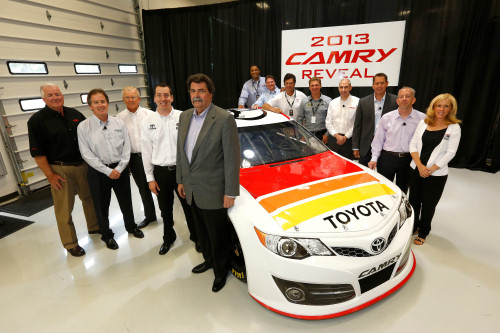 © Toyota Racing "They're good partners," he remarked. "Their tires are probably the best that they've ever been in the history of our sport, at least as far as I know over the last thirty-some years. They're doing the best job that they've ever done and they've put more resources towards our tires than I've ever seen in my life. "That's critical to us being able to change the signature of this car a little bit and get it more mechanical and less aero dependent. Of course, aero never goes away. We all know that. As long as there's air, there's going to be an aero influence." Andy Graves believes sorting out the 2013 car will provide the teams with plenty of challenging work. "It's a little complex because it's not just the new body style," Graves said. "There are several tests in October and we'll also be testing a radical new rules package to increase mechanical grip and decrease the aero dependency. The current 2013 car as we designed makes basically the same aero numbers from a total downforce point of view as the cars on the racetrack today. That's the way we designed it. "But NASCAR are now tasking us to reduce the spoiler size and reduce the splitters and add some mechanical grip. They want to decrease the total weight of the vehicle and allow us to run some low rear camber in the hopes of increasing the grip you get from the tires and to decrease the aero significantly to try to rebalance the cars so that hopefully they run better in traffic or packs. "Even though the goal is to roll all of it out for 2013 it really is separate from the new body style and the project that the manufacturers worked on. We designed the cars to be at the same downforce level and they can make the same downforce level if not more than the current cars. But NASCAR want to cut the spoilers and splitters. We're getting ready for probably the biggest technical change that I've ever witnessed in the sport." Graves reflected on the lessons from F1 this season. "There's no doubt, and F1 has proved it more than ever this year, that the tire degradation rate plays a huge role in the quality of the racing," he observed. "You see it in Formula One this year. You don't know from week to week or from the beginning of the race until towards the end of the last stint who's going to come out on top. "So it's very interesting. As heavy as our cars are Goodyear has got a very hard challenge. In the past, we limited them on the amount of rear camber that you can run and their tires definitely operate at higher grip levels with more camber. Because the cars are so heavy they have to build tires that can hold up to that. In effect what it's turned into is drivers can run qualifying laps every single lap and rarely hurt a tire. "So they're throwing some major changes to the ratio of aero to mechanical grip and let Goodyear work on doing some development to bring some tires that you can't run qualifying laps on every lap. So it will put it a little bit back into the driver's style and how hard they can push. If you overuse a tire you're going to pay for it at the end of the stint as far as lap time is concerned. "If you don't include Daytona and Talladega," Graves added, "the greater the impact of this new rules package is going to be at any tracks where we see really fast speeds. The Michigans, Fontanas and all the mile-and-a-half tracks are going to be pretty exciting. It's going to be a big challenge to work on if this if it's what NASCAR settles the rules package on. From the engineers point of view it's a fantastic challenge to try to get an advantage and work out your package. It's definitely going to be very interesting." 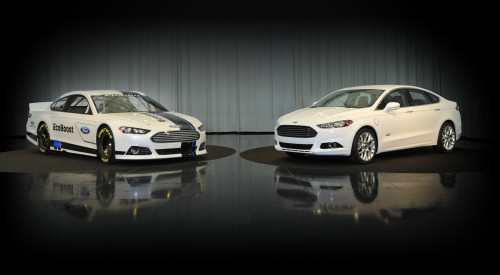 © Ford Racing "Looking back on the eighteen years I've been doing it," di Marco remarked. "When I started with the Truck series back in 1995 they had a hundred pounds of lift on the front end. They didn't even have downforce at that point and now the trucks are running around with more downforce than the Cup cars have. So the aero dependency is significant and as teams and engineers get smarter and tools get better you develop a package that is very aero dependent. "To take that away, one, the drivers don't like it because the cars are harder to drive, and two, it goes against the development of a race car. Everybody wants to make more downforce to go faster from Formula One to V8 Supercars to your Saturday night racer." Meanwhile, even as the Chase for the Cup unfolds NASCAR's teams are busy building and testing new 2013 cars. "They're as full-bore as they can be right now," Robin Pemberton remarked. "The sheet metal is forthcoming, so they'll be turning cars out pretty soon." Added Andy Graves: "We have several cars built between JGR and MWR and we're getting ready to test. I also have two other smaller teams that have sheet metal kits. They haven't hung the bodies yet, but are waiting to as soon as the test results are in. The process is definitely moving along. It'll be a challenging winter, for sure, but these are exciting times." It's easy to criticize NASCAR, but their technical and competition people provide an object lesson in how a motor racing sanctioning body should work with its manufacturers and teams. Most other forms of racing--in America at least--could learn a thing or two from them. |
Auto Racing ~ Gordon Kirby Copyright 2012 ~ All Rights Reserved |
